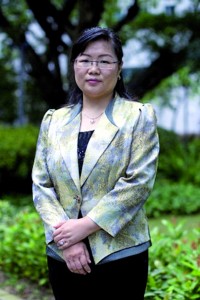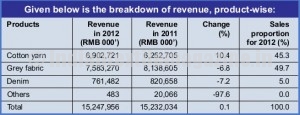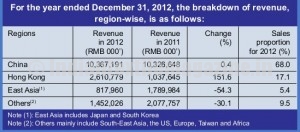
Weiqiao Textile Company Ltd., a non State-owned enterprise, is the largest cotton textile producer in China, specializing in the production, sales and distribution of cotton yarn, grey fabric and denim. In the past 10 years, the group developed large-scale production capabilities by capitalizing on China’s rapid economic growth. It has achieved a stable position in the global textile markets by employing advanced technology in its state-of-the-art facilities.
Weiqiao Textile is located in Shandong, China’s second largest cotton producing province. It has four production bases, in Weiqiao, Binzhou, Weihai and Zouping, and employs approximately 82,000 people. As at December 31, 2012, the group produced approximately 450,000 tons of cotton yarn, 1,045,000,000 metres of grey fabric and 89,000,000 metres of denim.
Since the beginning of 2012, the Chinese textile industry has been facing a very complex and volatile environment both domestically and overseas. A variety of adverse factors such as weak demand in overseas markets, slowing growth in domestic markets, widening gaps between domestic and overseas cotton prices, and increasing production costs has resulted in a notable slowdown in China’s textile industry. However, growth rates of the textile industry’s major economic indicators have picked up slightly since September of 2012 due to stable growth in domestic demand, adjustments made by enterprises in commodity inventory levels, and lower comparable basis in 2011, while the gap between domestic and overseas cotton prices continued to widen, and demand from international markets remained sluggish, leaving the prospect for an industry recovery a little uncertain.
In 2012, as market conditions in the textile industry were grim, the group recorded revenue of approximately RMB 15,248 million, about the same level as in 2011. Net profit attributable to owners of the parent company was approximately RMB 482 million, representing an increase of 95.9 per cent as compared with 2011. Earnings per share were RMB 0.40. The Board recommended payment of a final dividend of RMB 0.1246 per share (tax inclusive) for the year ended December 31, 2012.
During the year, the group’s production volume of cotton yarn, grey fabric and denim were approximately 450,000 tonnes, 1,045 million metres and 89 million metres, respectively. The production volume of cotton yarn, grey fabric and denim decreased by approximately 27.2 per cent, 10.3 per cent and 12.7 per cent respectively, year over year. The decrease was mainly because of intense competition in the industry during the year under review as a result of the weak demand in the textile products market and large cotton price gap between domestic and overseas markets. The group adjusted its production plan in order to reduce its inventory level.

Commenting on the company’s performance in 2012, Ms. Zhang Hongxia, Chairman of Weiqiao Textile, said: “During the year, the international market for textile products and apparel remained sluggish due to the adverse effects of the weak recovery in the global economy and the sovereign debt crisis in Europe, while competition became more intense. In addition, part of export orders for textile products and apparel began shifting from China to neighboring countries with lower production costs, especially for lower-end products, thereby further intensifying international competition. In 2012, domestic cotton prices remained stable while overseas cotton prices declined continuously, making overseas cotton much cheaper than domestic cotton. As a result, cotton costs remained high for textile companies in China, which adversely affected the competitiveness of Chinese companies in the global markets. We were also affected to some extent.”

“Looking into 2013, the recovery of the global economy still holds many uncertainties. As a result, Weiqiao Textile will continue to improve its product mix, encourage innovation, strengthen its brand image, and further enhance its profitability. In the meantime, by leveraging the group’s competitive advantages, which include global cotton procurement channels, self-generated electricity and steam supplies, Weiqiao Textile will continue its efforts to control costs and maintain, or even increase, its market share in the face of continued market turbulence through proactive sales strategies and flexible pricing policies. The group’s management believes that its operating efficiency and strategy will benefit once the market recovers”, she added.
Despite the challenging market conditions, Weiqiao Textile Company continued to strengthen its business development capabilities, internal management and cost controls, as well as optimizing resource allocation. It also continued to further optimize its product portfolio to cater to market demand and took a more flexible sales strategy to reduce the inventory level of finished products, increased the proportion of medium and high-end products, and made other improvements across its value chain from research and development to procurement, production and marketing and sales, so as to ensure its stable operation.
The revenue generated from sales of cotton yarn, grey fabrics and denim were 45.3 per cent, 49.7 per cent and five per cent respectively.

For the year ended December 31, 2012, the proportion of the group’s revenue from cotton yarn increased compared with the corresponding period of the previous year, while the proportion of revenue contributed by grey fabric decreased. It was mainly because the group adopted a flexible sales strategy to reduce cotton yarn inventory according to the changes in market demand that led to an increase in revenue generated from cotton yarn. The proportion of revenue from denim remained at about the same level as compared with the corresponding period of the previous year.
Selling and distribution expenses
The group’s selling and distribution expenses increased by 14.4 per cent to approximately RMB 206 million for the year ended December 31, 2012, from approximately RMB 180 million for the corresponding period of the previous year. In particular, transportation costs increased by approximately 15.4 per cent to RMB 150 million from RMB 130 million in 2011, which was mainly due to the increased sales volume of the group products during the year. Salary of the sales staff was approximately RMB 28 million, representing an increase of 64.7 per cent as compared with RMB 17 million for the corresponding period of last year, which was primarily due to the increase in the group’s domestic sales during the year, which resulted in the increase in sales staff’s salary.
Sales commission was approximately RMB 10 million, representing a decrease of 47.4 per cent as compared with approximately RMB 19 million of the corresponding period of the previous year, which was primarily due to a decrease in the group’s overseas sales through intermediate traders during the year, which resulted in a decrease in the commission paid accordingly.
Administrative expenses of the group for the year ended December 31, 2012, amounted to approximately RMB 252 million, representing an increase of 9.1 per cent as compared with approximately RMB 231 million of the corresponding period of the previous year. It was primarily due to the upward adjustment of the salary of the administrative management staff.
Finance costs
For the year ended December 31, 2012, finance costs of the group were approximately RMB 629 million, representing an increase of 34.4 per cent as compared with RMB 468 million of the previous year, among which interest expenses amounted to approximately RMB 599 million, representing an increase of 5.3 per cent as compared with RMB 569 million of the previous year. This was mainly attributable to the increase in the interest rates of bank borrowings during the year. The exchange loss amounted to approximately RMB 30 million for holding a large amount of balances of payables and loans denominated in the US dollar, which was affected by the depreciation of the Renminbi, while an exchange gain of RMB 102 million was recorded in the previous year.